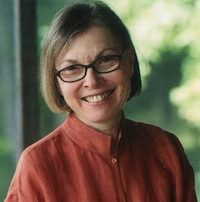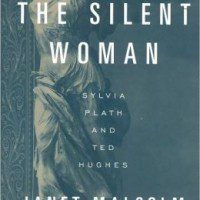I discovered The Silent Woman, Janet Malcolm’s portrait of Sylvia Plath and Ted Hughes, last fall and read it in just one sitting, the book in one hand and a champagne flute of white wine in the other. I had recently broken all of my wine glasses. I did not break them all at the same time. Some I broke while cleaning, and I was upset that I had managed to destroy something while trying to make it clean, make it better. Other glasses were broken using more theatrical methods, smashing them against walls to prove points. I had also recently broken my bed frame, cracked a rib, and wrecked a series of valuable relationships. Broken things had become my metric. It was fall and this book fell on my head in the Strand. It was fall and everything was falling out of place. It was fall and I felt, constantly, as if I were in a state of vertigo. I could go on. I won’t.
By the time The Silent Woman fell on my head (paperback, thankfully) I had already ended my love affair with Sylvia Plath. I was young when I first read Sylvia, but old enough that I had no hero-worship. A teacher of mine gave me a copy of The Bell Jar when I was just 15 and I was so offended by what I assumed to be the implication that I did not read it. I took everything personally when I was 15. Now I only take some things personally.
I finally got around to reading The Bell Jar when I was a freshman in college and was embarrassed by all of the things that my smarter, more discerning peers had read and watched and listened to. I didn’t know where to start in order to catch up. I started with The Bell Jar.
I didn’t love The Bell Jar, but the woman who had written it fascinated me. Sylvia Plath. I knew she had committed suicide. Everybody knows that Sylvia Plath committed suicide. My knowledge of her life and death stopped there.
I picked up a copy of her unabridged journals shortly thereafter and consumed it as if it was a steak and I was starving. When I finished, blood was dripping down my chin.
After that was Ariel, which I read with equal appetite. I rode the Sylvia train for many years before getting off and moving on to new obsessions. But then, years after reading the first lines of The Bell Jar, The Silent Woman hit me on the head. I do not believe in fate. I believe that the Strand has a great deal of inventory and that sometimes their bookshelves become overcrowded, so that when you pull one book out, another might fall and hit you on the head. If I did believe in fate, however, this might be the kind of event that I would point to as evidence.

The Silent Woman is not a biography of Sylvia Plath, not really. It’s a book about writers who, in Malcolm’s words, “sacrificed their life as a woman to become writers.” It is also a book about the relationship between Sylvia Plath and her husband, fellow poet Ted Hughes. Most of all, though, it’s a biography about biography, a meditation on the wrangling between Sylvia’s biographers and Ted and Olwyn Hughes, Ted’s sister and Sylvia’s sister-in-law. Malcolm writes that the biography is “a flawed genre.” She tells us that “the pose of fair-mindedness, the charade of evenhandedness, the striking of an attitude of detachment can never be more than rhetorical ruses.” Biographers, Malcolm argues, enter lives before asking if they are welcome and forage about for private, concealed information.
Every story needs its villain and Ted Hughes is often thought of as the beast in Sylvia’s life, the man who metaphorically brought her to that infamous oven and helped her fill up mugs of milk and arrange plates of bread for their children to find when they awoke. He was unfaithful and his infidelity, undeniably, broke Sylvia, made her lose something that she could not live without. “When you give someone your whole heart and he doesn’t want it, you cannot take it back. It’s gone forever,” Sylvia told her friend and The Bell Jar dedicatee Elizabeth Sigmund. A great deal of evidence points to the idea that Ted, too, saw himself as the catalyst for Sylvia’s suicide. “It doesn’t fall to many men to murder a genius,” he told Sigmund, years after Sylvia died.
But while every story needs its villain, the lives of others are not stories, even when we present them as such. Stories connect events; they assume motives and assign characters. Malcolm, more so than any other Plath biographer, extends empathy to the Hughes siblings, especially Ted. She writes: “Whatever Hughes might have undone or redone in his relationship to Sylvia Plath, the opportunity was taken from him when she committed suicide, in February of 1963.” She goes on to compare the scrutiny he had to endure from biographers, scholars, and journalists to the life of the Greek Titan Prometheus, “whose ravaged liver was daily reconstituted so that it could be daily reravaged.”
I did not know what Ted Hughes looked like prior to reading The Silent Woman, but I was so compelled to learn the structure of his face that I set down my champagne flute and stopped reading to look up his image. I searched “Ted Hughes”, and then “young Ted Hughes” because I wanted to see the version that Sylvia knew. He appeared to me as a compilation of every boy I’ve ever loved. He could haven been their leader, with his craggy face and his strong, serious brow. A chin that could cut you. Eyes that demanded contact and hands larger than the back of my head. Was it any wonder that, when they first kissed, Sylvia found herself so overcome with virile energy that she bit into his cheek so hard she drew blood? There are women who fix things and women who break things, and Sylvia and I are women who break things, even when we are trying to clean them.
What The Silent Woman does best is showcase how no one is innocent, neither the biographers nor the people they write about. Yes, biographers enter rooms without asking and press down on painful bruises, but the subjects of the biographers behaved in such a way that the biographers felt compelled to search and press. They’re all just pressing down until something breaks. It points to Malcolm’s great skill as a writer that it was only weeks after I finished The Silent Woman that I realized she, too, exhibited the biographer’s greed. She opens the book by vehemently condemning the motivations behind the biographers, calling them greedy and self-serving, but then we later find her rifling through the kitchen of Anne Stevenson, author of Bitter Fame: A Life of Sylvia Plath.
It was Stevenson who told Malcolm that “one of the things you must understand about Ted… is that women throw themselves at him. Ted is not always able to say no.” The Silent Woman is ballasted by people who found it difficult to say the word “no.” Sylvia Plath, Ted Hughes, Olwyn Hughes, the men and women who attempted to tackle a biography of Sylvia Plath prior to Malcolm, and even Malcolm herself — they all have difficulty resisting temptations. These temptations range from biting so hard you break blood to adultery to telling someone else’s story all the way to taking one’s own life.
I started The Silent Woman feeling that my tendency to break things was a singular experience. By the time I finished, I had more people that I related to than I had broken objects. I will not say that The Silent Woman and its version of Sylvia Plath and Ted Hughes’s story healed me. It did not. What I will say is not quite so lofty, but it is true: it made me, with my cracked rib and champagne flute but no champagne, feel better for breaking things when I was trying to clean them.





One response
I just purchased “The Silent Woman” by Janet Malcolm so I guess I still have a treat ahead of me. But just to comment on Anne Stevenson’s remark, “Women throw themselves at Ted.” So what. And Ted couldn’t always say “no”. Why? Because he was a complete idiot? Are we supposed to seriously take that as an excuse??????
Click here to subscribe today and leave your comment.